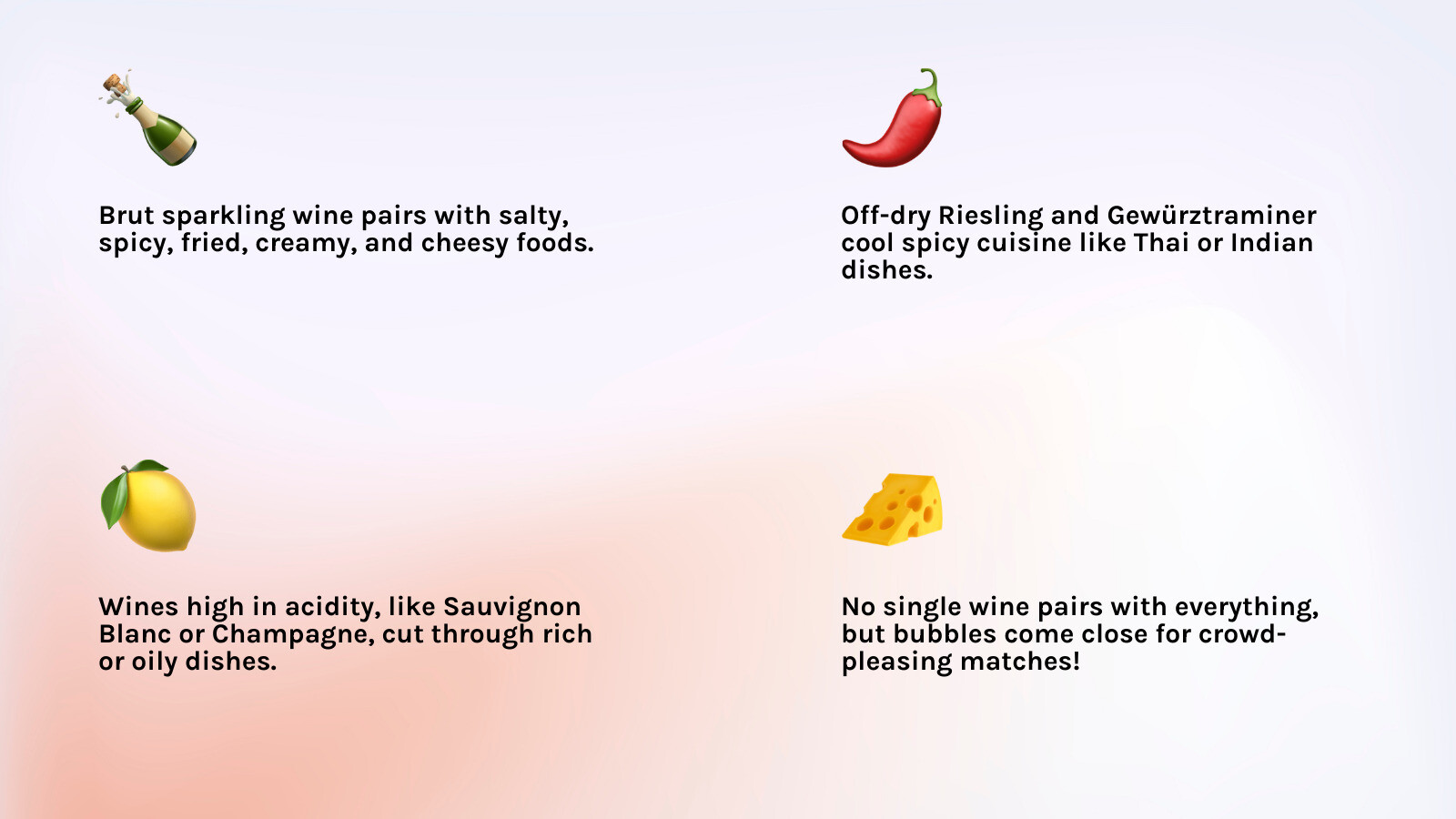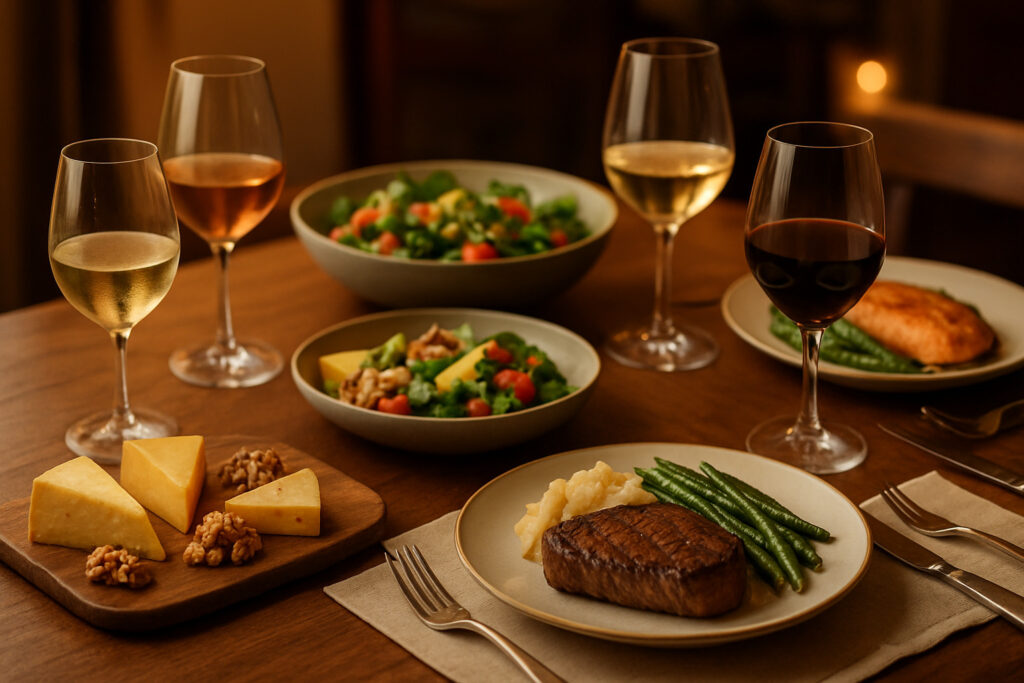Why Food and Wine Pairings Transform Your Dining Experience
Food and wine pairings can turn an ordinary meal into something magical. When done right, the combination creates flavors that neither the food nor wine could achieve alone.
Here’s what you need to know about successful pairings:
- Match intensity: Light wines with delicate dishes, bold wines with rich foods
- Balance elements: Use wine’s acidity to cut through fatty foods, tannins to complement proteins
- Consider two approaches: Complementary (contrasting flavors) or congruent (similar flavors)
- Focus on the sauce: Pair with the dominant flavor, not just the protein
- Start simple: Sparkling wine works with almost everything when in doubt
The science behind great pairings comes down to how different taste elements interact. Sweet wines balance spicy heat. Acidic wines brighten rich, creamy dishes. Tannic reds soften when paired with fatty meats.
As one master sommelier puts it: “Pairing wine and food is both a science and an art. Done right, it lifts a meal from ordinary to sublime.”
The key is understanding that about 20% of people are genetically wired to find highly tannic wines overwhelming. This means successful pairings consider your guests’ preferences, not just textbook rules.
Whether you’re planning a dinner party in New York City or exploring global cuisines, the right pairing improves every bite and sip. It’s about creating harmony between what’s on your plate and what’s in your glass.
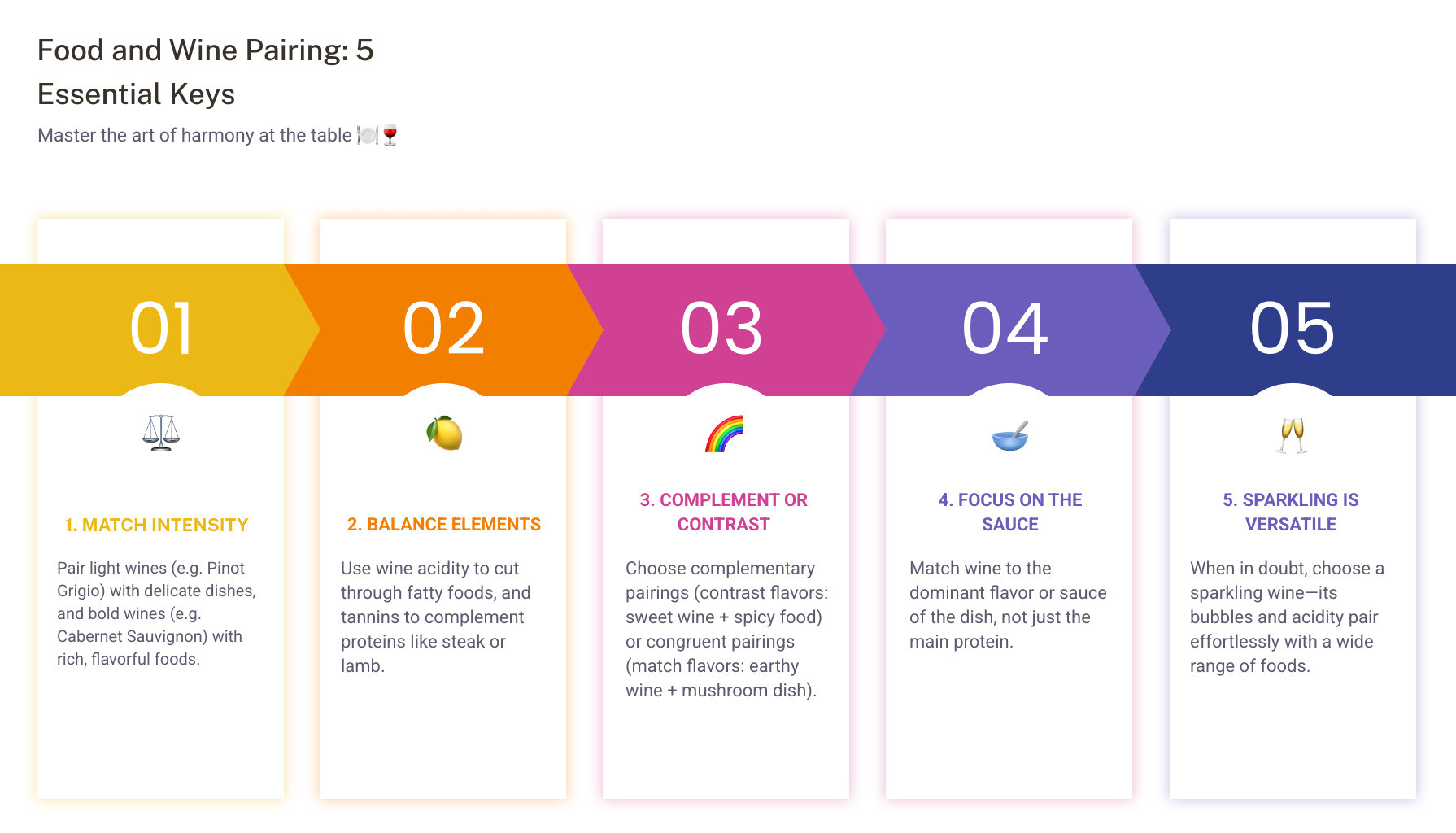
Food and wine pairings terms to know:
Fundamental Principles of Food & Wine Harmony
Creating beautiful food and wine pairings is like conducting a symphony—every element needs to work in harmony. The magic happens when the structural components of both food and wine complement each other perfectly, creating flavors that dance together on your palate.
Think of it as a delicate balancing act. When you understand how acidity, tannins, sweetness, body, and intensity interact, you’ll find why some combinations make your taste buds sing while others fall flat.
The 6 Basic Tastes and Why They Matter
Every memorable pairing starts with understanding the six basic tastes that appear in both food and wine. These taste elements are the building blocks of flavor harmony.
Sweet flavors show up in dessert wines and sugary dishes, while sour (acidity) gives wines like Sauvignon Blanc their crisp bite and makes tomatoes or vinaigrettes so bright. Salty tastes dominate in cheeses and cured meats (though wine rarely contains salt), and bitter notes appear in dark chocolate and the tannins that make red wine feel dry in your mouth.
Then there’s umami—that savory, almost meaty richness you taste in mushrooms, aged cheese, or soy sauce. Finally, fat adds richness to creamy dishes, marbled steaks, and buttery sauces.
Here’s where it gets interesting: these tastes can amplify or soften each other. Wine’s acidity works like a squeeze of lemon over your food, brightening every bite. Sweetness in wine can tame fiery spice, while tannins love to bind with fat and protein, making rich meats taste even more delicious.
For a visual breakdown:
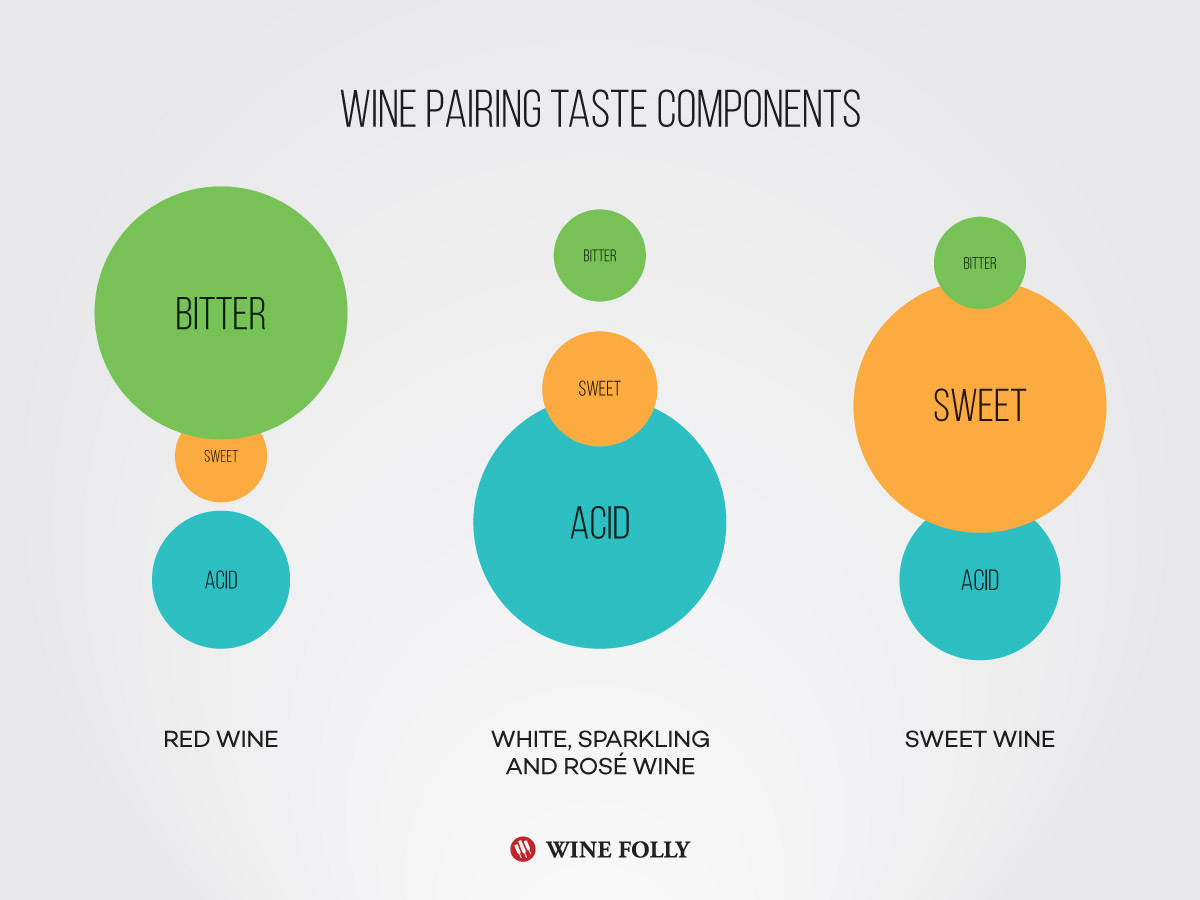
Matching Food & Wine Intensity
The golden rule of food and wine pairings is simple: match the weight and intensity of your wine with your food. Light-bodied wines like Pinot Grigio or Gamay shine with delicate dishes—think poached fish or fresh garden salads. Full-bodied reds like Cabernet Sauvignon or Syrah need robust, hearty fare such as grilled steak or braised lamb.
But here’s a secret many home cooks miss: focus on the sauce, not just the protein. A simple roast chicken becomes something entirely different when topped with a creamy mushroom sauce versus lemon and herbs. The sauce sets the dominant flavor and weight, so pair your wine accordingly.
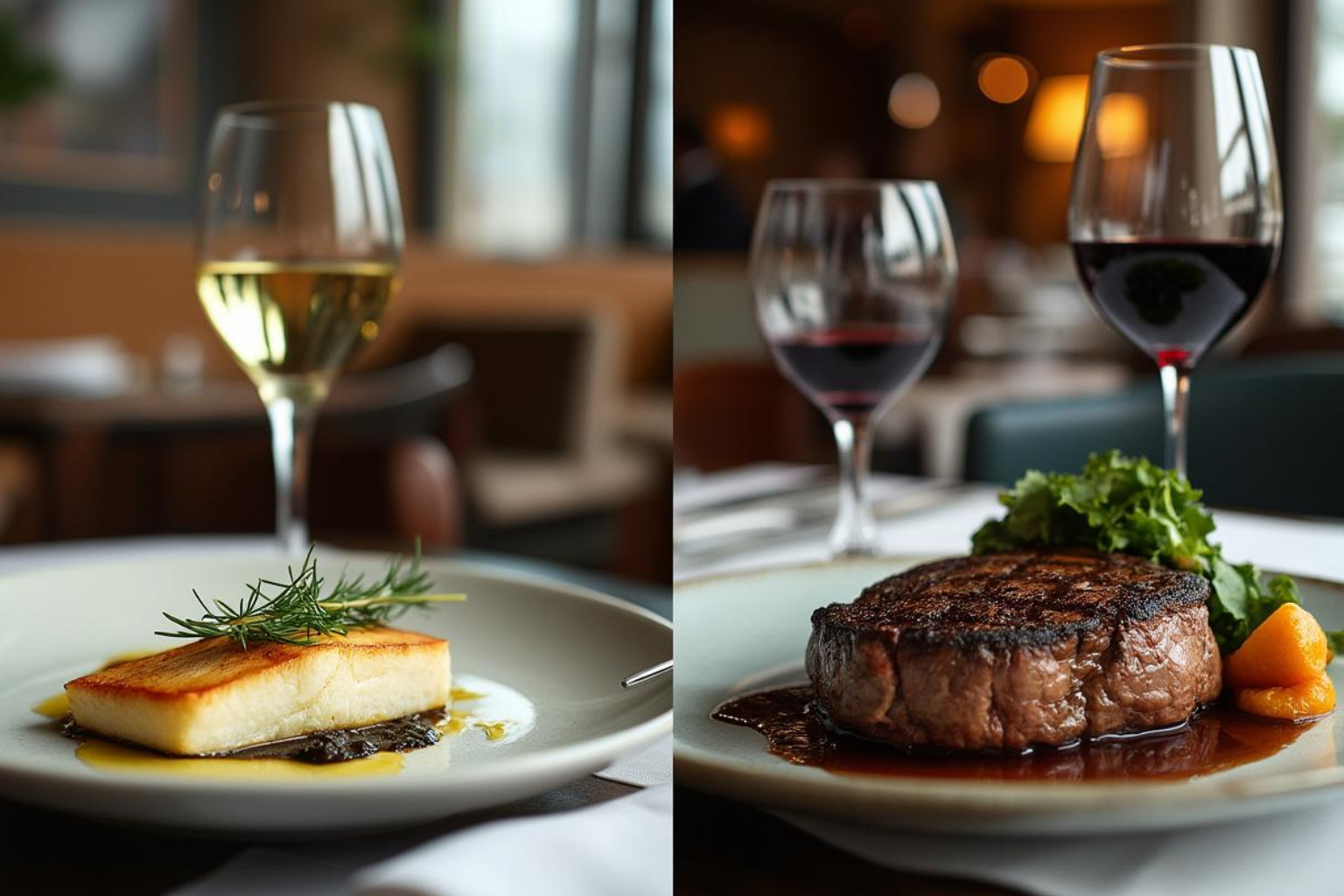
Food and wine pairings: Complementary vs Congruent in Action
When creating food and wine pairings, you have two main strategies that work beautifully. Complementary pairings use contrasting flavors and textures to create balance—like how a crisp, acidic white wine cuts through rich, creamy pasta, refreshing your palate with each sip.
Congruent pairings take the opposite approach, amplifying similar flavors in both wine and food. Think earthy Pinot Noir with mushroom risotto, or a buttery Chardonnay with lobster swimming in butter sauce. These pairings create flavor bridges and aroma overlap that make both elements shine brighter.
| Pairing Type | How It Works | Example |
|---|---|---|
| Complementary | Contrasts balance and refresh | Acidic Sauvignon Blanc + Fried Chicken |
| Congruent | Similar flavors improve each other | Earthy Pinot Noir + Mushroom Risotto |
The key is recognizing when to use each approach. Sometimes you want the wine to provide contrast and cleanse your palate. Other times, you want perfect harmony where wine and food seem made for each other.
For inspiration:

Pairings by Food Category (Meat, Fish, Veg & Spice)
Now that we understand the fundamentals, let’s dive into the exciting world of food and wine pairings by category. Each type of food has its own personality, and finding the right wine partner is like introducing two friends who’ll bring out the best in each other.
Red Meat & Fatty Dishes
There’s a reason steak and Cabernet Sauvignon became the ultimate power couple. Rich, marbled cuts like ribeye, lamb chops, or duck contain proteins and fats that literally bind with the tannins in bold red wines. This chemical romance softens the wine’s astringency while making the meat taste even more succulent.
Think of tannins as nature’s scrub brush for your palate. They cleanse away the richness, preparing your mouth for the next delicious bite. Cabernet Sauvignon and Syrah are your go-to partners here, but don’t overlook Malbec or a robust Côtes du Rhône.
The fattier your meat, the bigger and bolder your wine can be. A lean filet mignon might prefer a gentler Pinot Noir, while a marbled ribeye can handle the full force of a Napa Valley Cabernet.
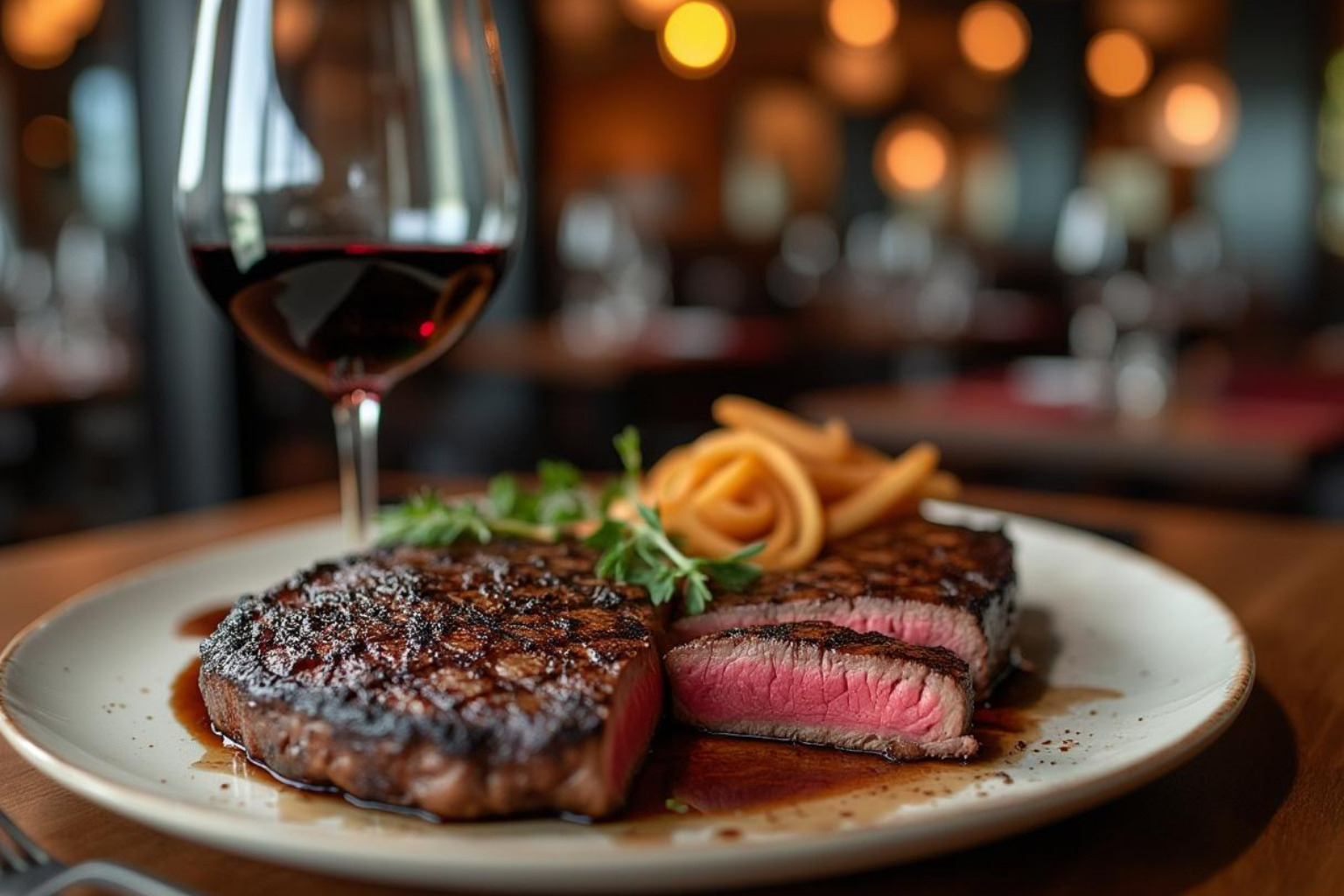
Poultry & White Meat Flexibility
Chicken and turkey are the diplomatic peacekeepers of the protein world. Their mild, adaptable flavors make them perfect canvases for both red and white wines, depending on how you prepare them.
Roasted chicken with herbs loves the buttery richness of Chardonnay or the bright red fruit of Pinot Noir. The wine choice often depends more on your cooking method than the bird itself.
Got a creamy sauce situation? Rich whites like Viognier or barrel-aged Chardonnay will echo those luxurious flavors. But if you’re grilling with bold spices, don’t be afraid to reach for a medium-bodied red like Grenache or Zinfandel.
The beauty of poultry is its versatility. It’s like having a reliable friend who gets along with everyone at the party.
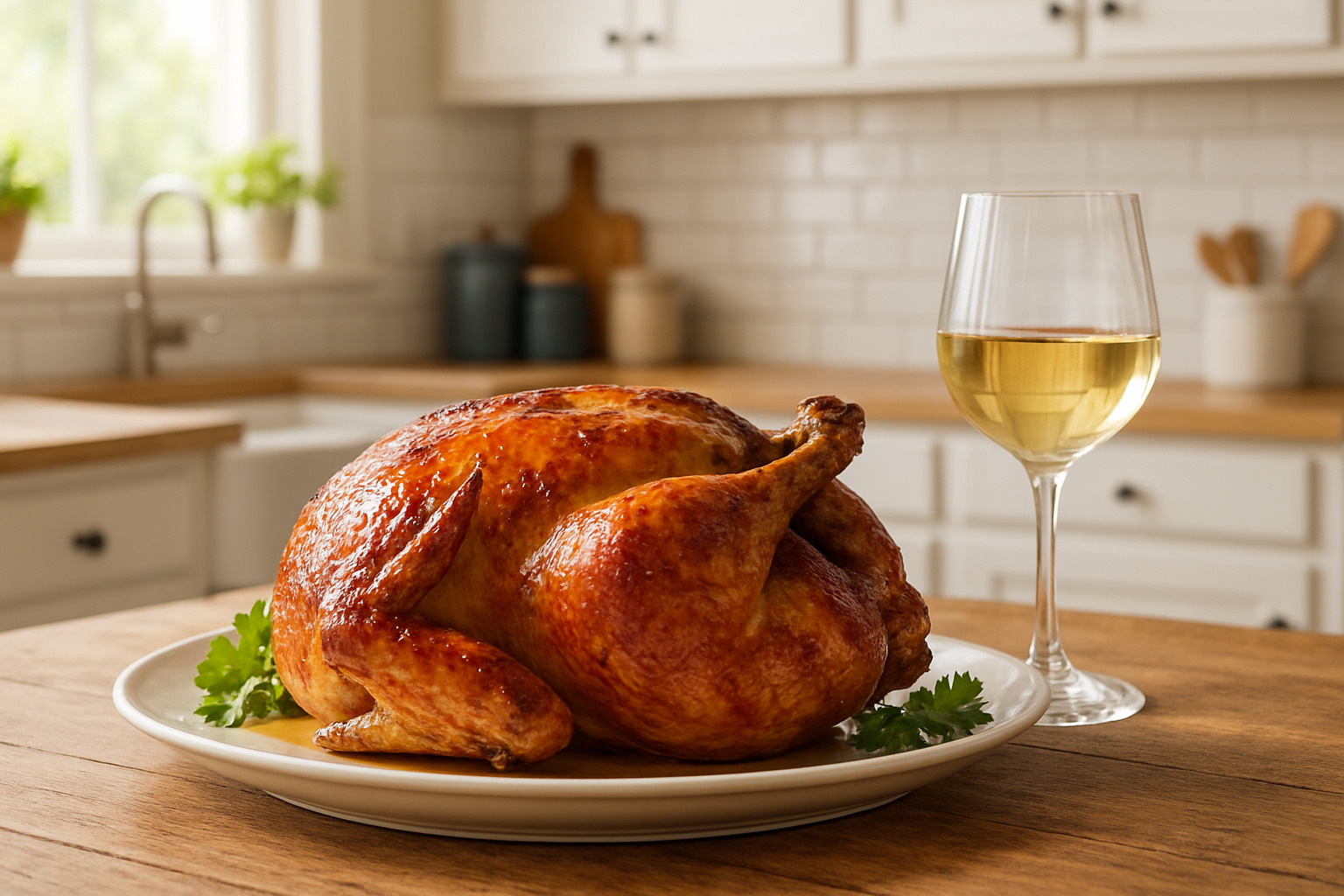
Fish & Seafood Nuances
Here’s where food and wine pairings get really interesting. Forget the old “white wine with fish” rule—it’s more nuanced than that.
Delicate white fish like cod or sole need gentle treatment. Think crisp, clean wines like Pinot Grigio or Muscadet that won’t overpower their subtle flavors.
But oily, meaty fish like salmon or tuna? They can absolutely handle red wine. Pinot Noir’s earthy undertones complement salmon beautifully, while the fish’s richness softens the wine’s edges. It’s a perfect example of why breaking traditional rules can lead to magic.
Shellfish practically begs for bubbles or the zesty freshness of Sauvignon Blanc. The acidity cuts through any richness while the effervescence cleanses your palate.
When your seafood gets spicy (think Thai-style preparations), reach for off-dry Riesling or sparkling wine to cool the heat.
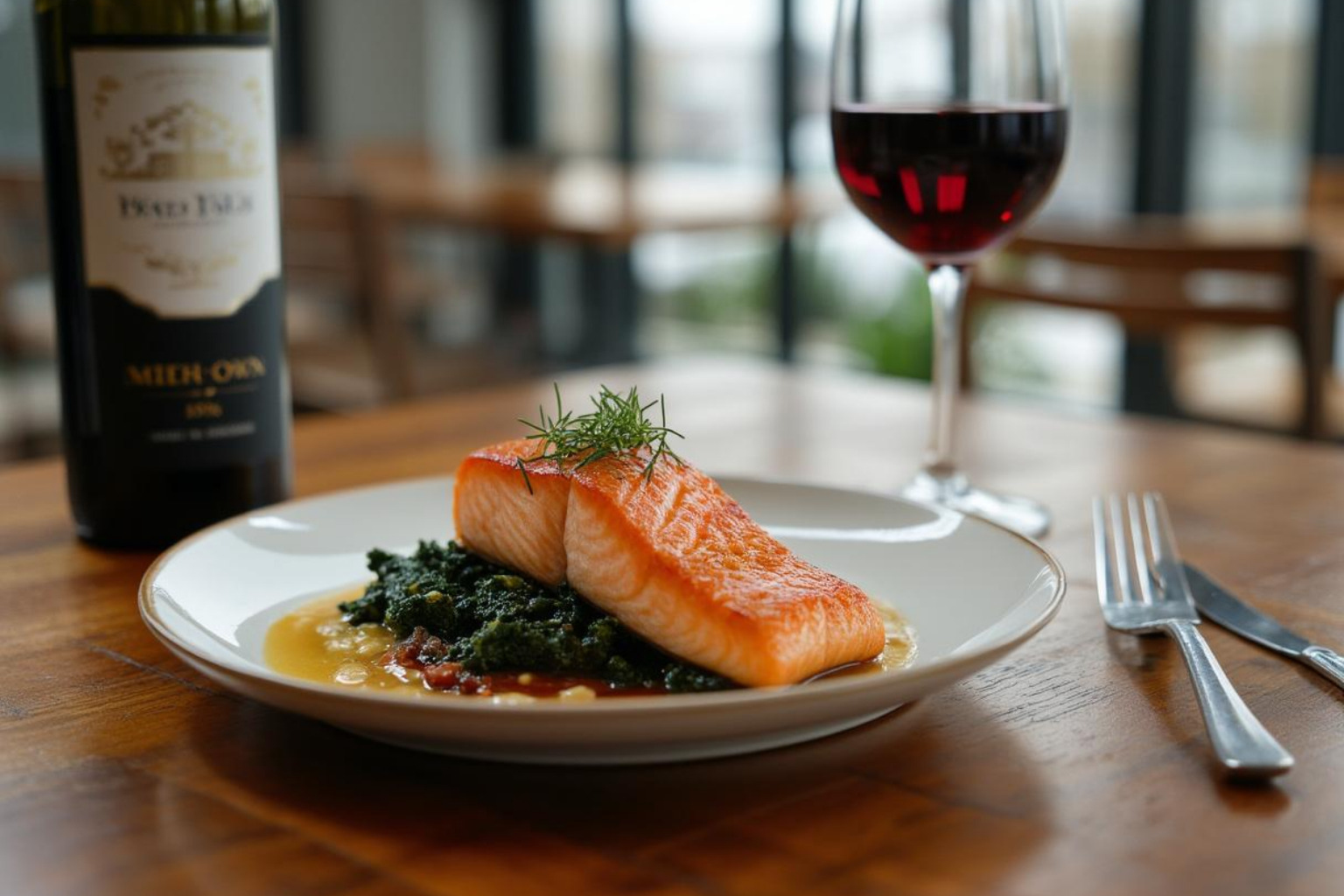
Vegetarian & Plant-Based Plates
Vegetarian cuisine deserves the same pairing attention as any meat dish. The key is focusing on preparation methods and dominant flavors rather than assuming all plant-based food needs light wine.
Fresh salads with vinaigrette shine alongside Sauvignon Blanc or dry Rosé. The wine’s acidity plays beautifully with the dressing’s tartness.
Grilled or roasted vegetables develop deeper, more complex flavors that can handle earthier wines. Pinot Noir loves anything with mushrooms, while Grüner Veltliner brings out the best in roasted root vegetables.
Hearty vegetarian mains like eggplant parmigiana or lentil stews can absolutely pair with red wine. Try Syrah with lentils—the wine’s peppery notes complement the earthy legumes perfectly.
For more wine trips: Best Places for Wine
Spicy & Sweet Challenges
Spicy food can be wine’s trickiest opponent. High-alcohol or tannic wines will make that Thai curry feel like molten lava in your mouth. The alcohol amplifies heat, creating an uncomfortable burning sensation.
Your cooling allies are off-dry Riesling, Gewürztraminer, and Moscato d’Asti. The touch of sweetness acts like a fire extinguisher, while lower alcohol levels won’t fan the flames.
Sparkling wines are also fantastic with spicy food. Those bubbles scrub away the heat while the acidity refreshes your palate. It’s like hitting the reset button between bites.
Save the big, bold reds for another night—unless you enjoy feeling like you’re breathing fire!
Explore more: Sparkling wines
Cheese & Appetizers
Cheese and wine pairings are where you can really have fun. The secret is matching intensity levels and thinking about texture contrasts.
Soft, creamy cheeses like Brie or Camembert love the bubbles in Champagne or the richness of Chardonnay. The wine’s acidity cuts through the cheese’s richness beautifully.
Tangy goat cheese and Sauvignon Blanc are a match made in heaven. Both have that bright, zesty character that makes your mouth water.
Aged cheeses like sharp cheddar or aged gouda need wines with enough backbone to stand up to their intensity. Cabernet Sauvignon or Malbec won’t be bullied by these flavor powerhouses.
For mixed cheese boards, sparkling wine is your secret weapon. Its acidity cleanses the palate between different cheeses, letting you taste each one clearly.
Desserts & Chocolate
Here’s the golden rule that’ll save you from dessert disasters: Your wine must always be at least as sweet as your dessert. Break this rule, and your wine will taste like bitter, sour disappointment.
Dark chocolate creates one of the most luxurious pairings when matched with Cabernet Sauvignon or Port. The wine’s richness complements chocolate’s intensity, while the slight bitterness in both creates harmony.
Fruit desserts pair beautifully with Moscato d’Asti, late-harvest Riesling, or demi-sec Champagne. The wine’s sweetness echoes the fruit without overwhelming it.
Nutty pastries find their perfect match in Madeira or sweet sherry. These wines have that same warm, toasted character that makes the pairing feel inevitable.
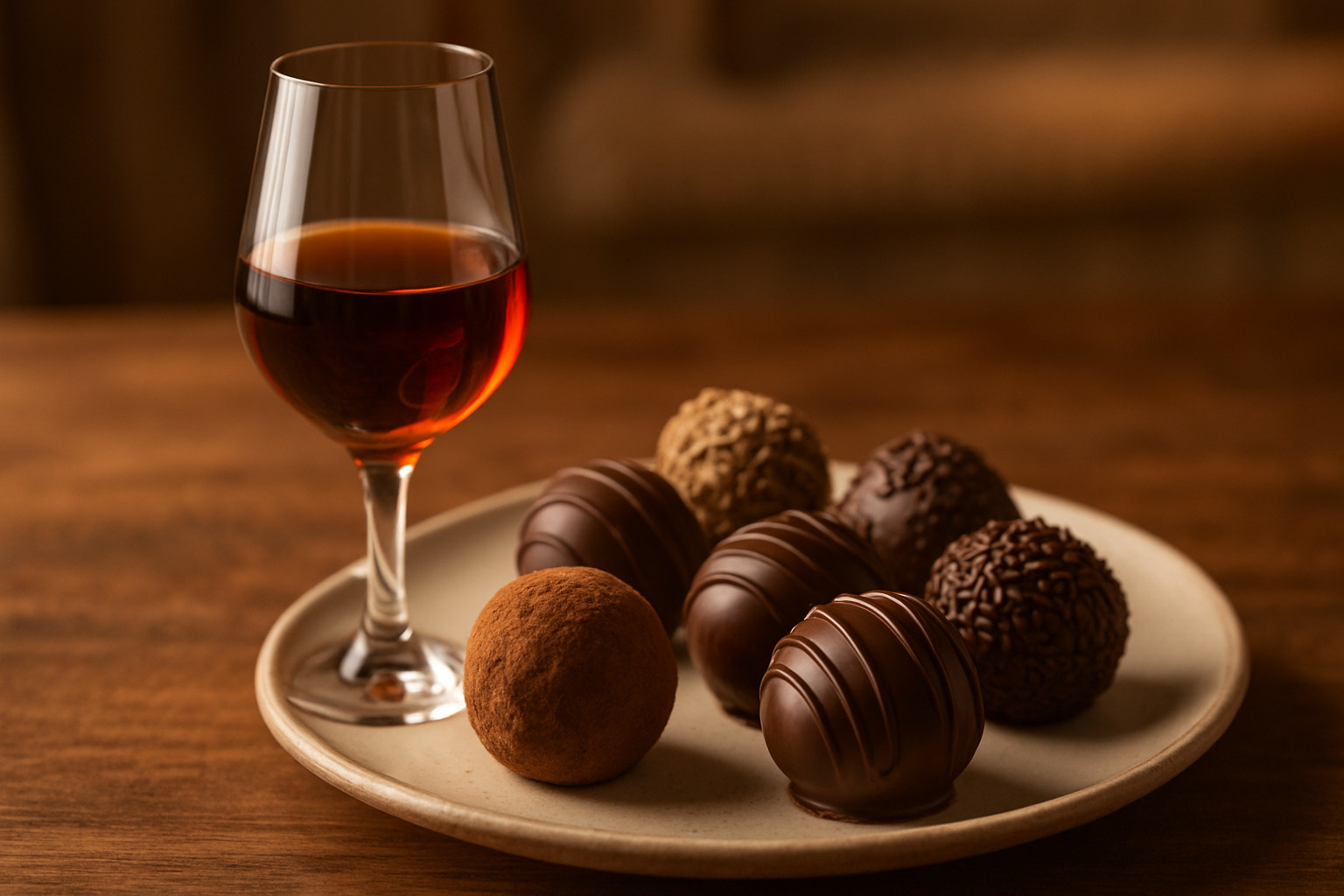
For a classic experience: Graham’s 20-Year Tawny
Beyond the Classics: Rules to Bend & Break
The old “red wine with red meat, white wine with fish” mantra works—until it doesn’t. Some of the most exciting food and wine pairings happen when you throw the rulebook out the window. Here’s how to get creative without creating chaos.
When to Break “Red Meat / Red Wine”
Sometimes breaking the rules creates magic. Red wine with fish can be absolutely stunning—try a chilled Pinot Noir with grilled salmon or tuna. The key is choosing reds with lower tannins and higher acidity, which won’t overpower delicate seafood.
White wine with steak might sound crazy, but a rich, oaked Chardonnay can absolutely stand up to grilled beef, especially when there’s a butter or cream sauce involved. The wine’s richness matches the meat’s intensity.
Rosé deserves special mention here—it’s the ultimate rule-breaker wine. Dry rosé bridges the gap between red and white, handling everything from charcuterie to grilled vegetables with equal grace. Think of it as your diplomatic wine that gets along with everyone.
Regional Wisdom: “Grows Together, Goes Together”
This is the secret weapon of top sommeliers: pair wines and foods from the same region for natural harmony. Italian Chianti with tomato-based pasta isn’t just tradition—it’s culinary science. The acidity in both the wine and tomatoes creates perfect balance.
French Sauvignon Blanc with goat cheese, Spanish Rioja with lamb stew, German Riesling with spicy sausages—these combinations evolved over centuries for good reason. The terroir that produces the wine also influences the local cuisine.
Cooking Methods Matter
How you cook your food completely changes the ideal wine pairing. Grilled or roasted dishes develop smoky, caramelized flavors that call for robust reds or oaked whites. That char from the grill adds weight and intensity that needs a wine to match.
Poached or steamed preparations keep flavors light and subtle, making them perfect partners for delicate whites or sparkling wine. The gentle cooking method preserves the food’s natural character.
Braised dishes develop deep, rich flavors through slow cooking, making them ideal for fuller-bodied reds or whites with creamy textures. Fried foods need high-acid wines or bubbles to cut through all that delicious grease and refresh your palate.
Budget-Friendly Strategies for Everyday Food and Wine Pairings
Great food and wine pairings aren’t about price tags. Some of the best matches come from value regions and lesser-known grapes that deliver big flavor without breaking the bank.
Try Côtes du Rhône instead of expensive Burgundy—you’ll get similar earthiness and elegance at a fraction of the cost. Portuguese reds, South African Chenin Blanc, or Argentine Malbec offer incredible value and pair beautifully with everyday meals.
Sparkling wine on sale is always a smart buy. It’s the universal pairing champion that works with everything from fried chicken to birthday cake. Stock up when you find a good deal.
For more inspiration: Best Wine Vacations in the World
The best part about breaking pairing rules? You might find your new favorite combination. Check out these 5 golden rules for food and wine pairing to understand which rules are worth bending and which ones you should respect.
Frequently Asked Questions about Food and Wine Pairings
Let’s tackle the most common questions we hear about food and wine pairings. These are the real-world situations that stump even seasoned home cooks.
What wine pairs best with spicy Thai or Indian dishes?
Here’s the thing about spicy food—it can turn your favorite bold red into liquid fire. The secret is choosing wines that cool rather than amplify the heat.
Off-dry Riesling is your best friend here. That touch of sweetness acts like a cooling balm against chili heat. Gewürztraminer and Moscato d’Asti work the same magic. The lower alcohol content is key too—high-alcohol wines make spicy food feel even hotter.
Don’t overlook sparkling wine either. Those bubbles are like tiny palate cleansers, washing away the heat and prepping your mouth for the next flavorful bite. It’s why Thai restaurants often serve beer—the bubbles and lower alcohol do the same job as a good Prosecco.
How do acidity levels in wine affect pairings?
Think of acidity in wine like a squeeze of fresh lemon over your food. It brightens everything up, cuts through richness, and makes your mouth water for more.
High-acid wines like Sauvignon Blanc or Champagne are perfect with fatty, creamy, or fried foods. That bright acidity slices through butter, cream sauces, and rich cheeses like a knife. It’s the same reason we squeeze lemon on fish and chips—the acid balances all that oil.
When you’re eating something rich and your palate feels coated, reach for a crisp, acidic wine. It’ll refresh your taste buds and make each bite taste as good as the first.
What’s a safe “when in doubt” bottle?
Brut sparkling wine is the ultimate crowd-pleaser and pairing champion. Whether you’re ordering takeout, hosting a potluck, or facing a mixed menu, bubbles rarely let you down.
The combination of high acidity, effervescence, and low tannins means sparkling wine plays well with almost everything. Salty snacks, spicy takeout, fried chicken, cheese boards, sushi—you name it. The bubbles cleanse your palate, the acidity cuts through rich foods, and the festive factor makes any meal feel more special.
When you’re planning a dinner party in New York City or just want one bottle that works with whatever’s in your fridge, sparkling wine is your answer. It’s the Swiss Army knife of wine pairings.
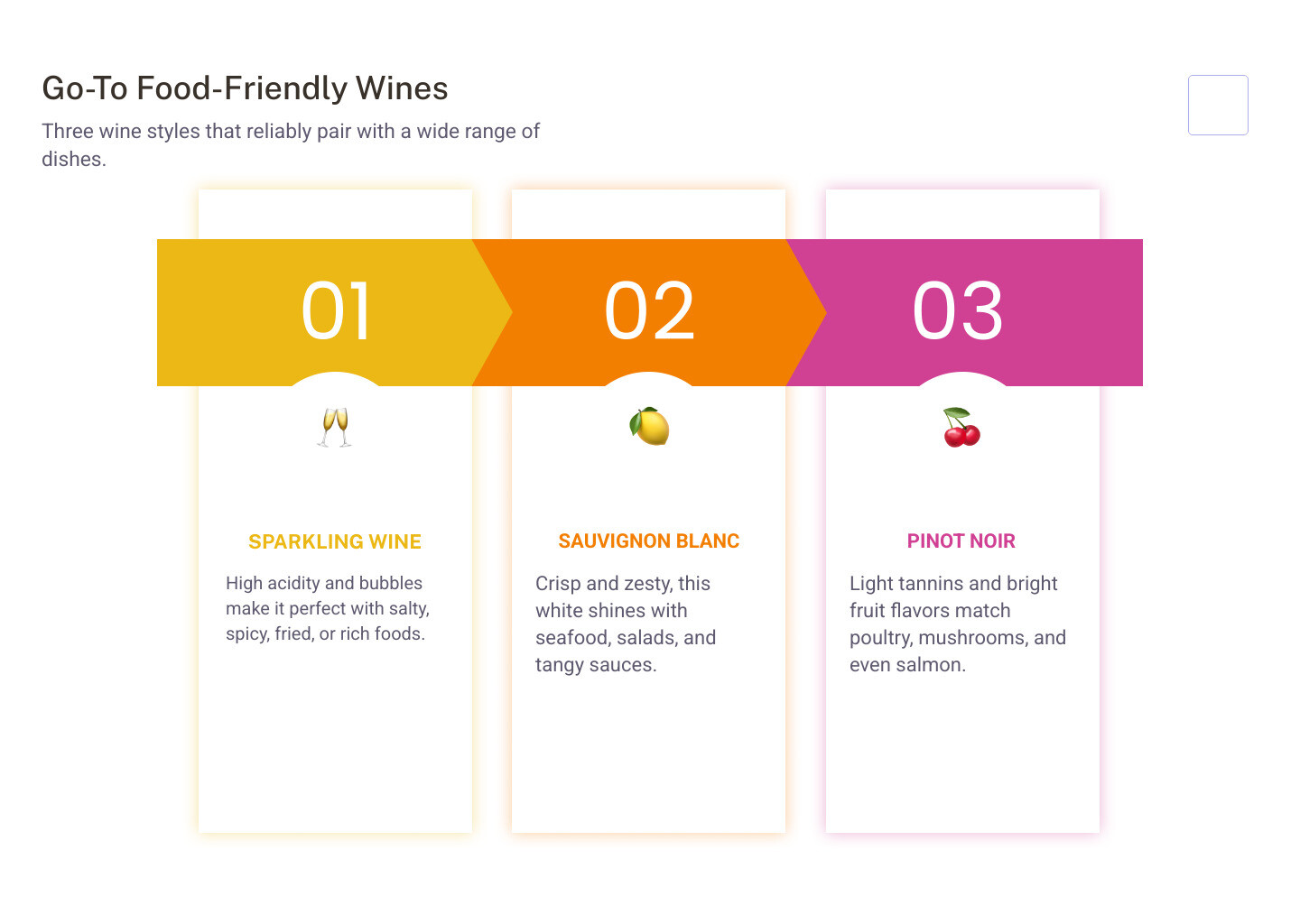
Conclusion
The beauty of food and wine pairings lies not in following a rigid playbook, but in finding what makes your taste buds sing. Think of everything we’ve covered as your starting point—a foundation to build on, not rules carved in stone.
The truth is, the “perfect” pairing is deeply personal. Maybe you love that crisp Sauvignon Blanc with your Friday night pizza, even though it breaks every traditional rule. Or perhaps you’ve finded that a light Pinot Noir makes your vegetarian pasta sing in ways you never expected. Trust those instincts.
Start with the basics we’ve shared: match intensity levels, balance acidity with richness, and remember that sweetness soothes spice. But don’t stop there. The real magic happens when you start experimenting—trying that Spanish Tempranillo with your homemade tacos, or finding how a glass of Champagne transforms your Tuesday takeout into something special.
At The Dining Destination, we believe that great food and wine experiences shouldn’t be reserved for special occasions or fancy restaurants. Whether you’re exploring the incredible dining scene in New York City or planning your next culinary trip, the right pairing can turn any meal into a memorable moment.
Even the most renowned sommeliers started as curious beginners. They learned by tasting, trying, and sometimes making delicious mistakes. Your palate is unique, and the combinations that work for you might surprise everyone—including yourself.
Ready to dive deeper into culinary trips? Explore our guide to Best Culinary Experiences and start planning your next flavor journey. After all, the best food and wine pairings are the ones that create lasting memories, one perfect sip and bite at a time.
